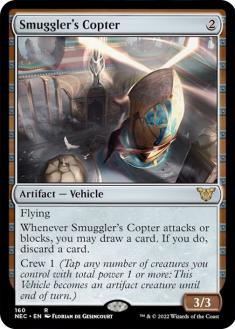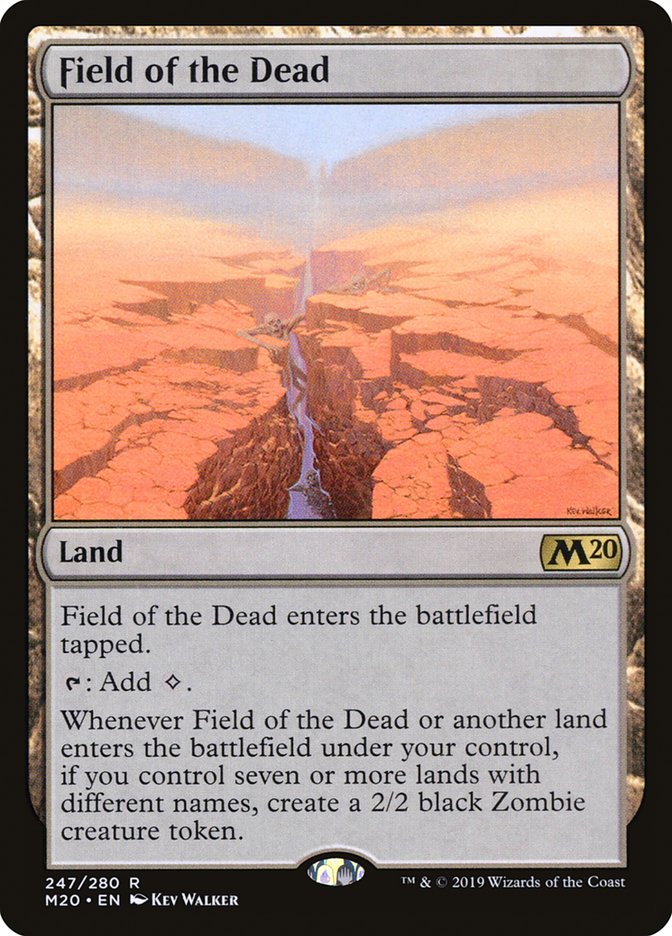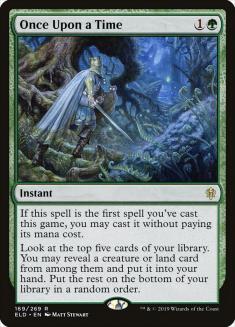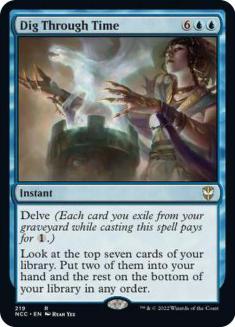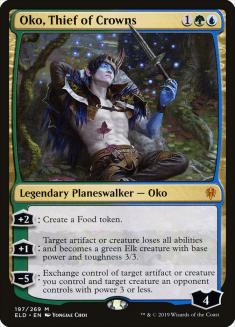Welcome to another edition of Fact or Fiction! Today Ari Lax, Sam Black, and Ross Merriam are here to give their takes on five statements on the December 2nd Pioneer Banned & Restricted Announcement. Don’t forget to vote for the winner at the end!
1. Banning Smuggler’s Copter in Pioneer was a good decision.
Ari Lax: Fact. Smuggler’s Copter is by far the least egregious card that was banned today. Its two big sins are being colorless and making aggro sweeper-proof by default so true control was dicey. If Smuggler’s Copter was the best card in a non-rotating format, that would be a good thing.
But the clear best deck in Pioneer was Mono-Black Aggro, and the only decks in the format standing up to it played cards that were really problematic. If you started swinging the hammer at the real problems in the format you had to take a shot at Mono-Black Aggro, and the options were Scrapheap Scrounger, Smuggler’s Copter, and Thoughtseize.
Thoughtseize is the most powerful of these cards but is more a safety valve than an issue. Scrapheap Scrounger is very similar in resiliency and ease of use to Smuggler’s Copter, but is just more vulnerable and cost-committal.
So sadly, Smuggler’s Copter had to go. I expect this to be the Bloodbraid Elf of Pioneer, where in a few years it gets unbanned and everything is fine, but for now it takes the hit.
Sam Black: Fact. Smuggler’s Copter didn’t have to go. It homogenizes aggressive decks, but because it’s colorless and very flexible, it does it in a pretty benign way as far as collapsing a metagame so it’s a reasonable kind of powerful card to have in the format. However, Mono-Black Aggro was a very good deck that stayed at the top of the format for an extended period, and with two other cards that weren’t in that deck leaving the format, there’s a real risk that it would have taken over.
I don’t know the win percentage for Mono-Black Aggro this week. They do, but they gave us less information about the numbers behind their decisions than they usually do, but I assume that things were pretty extreme given that they made this decision. A case could be made that with Field of the Dead out of the format, the format could have self-corrected. Given Smuggler’s Copter’s history, it’s reasonable to expect that long-term it would be too warping for the format even if people were able to adjust to it. Basically, just because a card can be beaten if people build their decks to do so, it does not necessarily follow that the format is better for it.
Castle Locthwain or Mutavault potentially could have taken the fall instead of Smuggler’s Copter, but I currently think they both do more good for the format, as I like lands that resist flooding and reward playing fewer colors.
Ross Merriam: Fact. I love Smuggler’s Copter. I would’ve enjoyed playing with it for years to come should it have survived. But Mono-Black Aggro was clearly too good. We got so much data in the last week from the many Pioneer PTQs and day after day we saw a pile of Mono-Black Aggro decks at the top of the standings. It plays an eminently fair game, but the combination of speed, consistency, resilience to removal, and card advantage going long was too much.
Mono-Black Aggro needed to take a hit, and there wasn’t another realistic option. The creatures are all replaceable; the utility lands, while powerful, wouldn’t have a huge hit on the deck because Smuggler’s Copter provides plenty of flood insurance already; and taking out Thoughtseize would have far-reaching negative ramifications for the rest of the format.
Aggro decks will be fine, and now the countermeasures to them, particularly from reactive decks, will get a lot better. That’s a win.
2. Banning Field of the Dead in Pioneer was a good decision.
Ari Lax: Fact. Field of the Dead isn’t a card with uncapped power level the way something like Rite of Flame or Faithless Looting is, where the possible combos spiral out of control over time and become power vortexes that dominate a format. It caps at “I’ll start making Zombies around Turn 4 and not stop until someone dies.”
But Pioneer is not aiming for a power level above that cap in the medium term. Field of the Dead in Pioneer strangles a large number of midrange and control decks out of the metagame. I know I’ve said those decks aren’t fundamentally good in Pioneer, but there’s a difference between “not good but might be metagame bullets” and “literally unplayable.”
You could argue not banning Field is an interesting way to promote weird combo decks like Lotus Field that do go over the top of ramp decks, but I’m fine with this reality where we didn’t argue it and gave Siege Rhino a chance.
Sam Black: Fact. I’ve been calling for this for a few weeks, since before it was really winning anything. The interaction with Hour of Promise is just too much better than every other long game in the format, so it stops too many possible decks from existing. I genuinely don’t think it matters how much Field of the Dead decks were winning as long as they’re doing well enough to see play in reasonable numbers, because that’s enough to force every other control deck to play their own Fields to keep up, and then the ramp deck is still favored over the control deck most of the time.
This card design is just a mistake. It’s too easy to make too many Zombies and too hard to interact with. It just has to make things worse rather than better, and clearly needed to leave the format eventually, and for my money, the sooner the better.
Ross Merriam: Fact. The numbers on Field of the Dead decks weren’t nearly as egregious as Mono-Black Aggro, but it had a negative impact on the metagame well beyond its own penetration, because Field of the Dead and Hour of Promise represented an unbeatable end-game engine for midrange and control decks.
Even with hate cards like Virulent Plague and Alpine Moon, Field decks commit few enough slots to the engine that they get to maindeck countermeasures and supplementary threats, so you’re in a situation where you need to find your hate card in a reasonable time frame to shut down Field, but your hate card is tenuous at best.
We basically haven’t seen midrange or control decks over the last two weeks of Pioneer tournaments, and Field of the Dead is the biggest reason why.
3. Banning Once Upon a Time in Pioneer was a good decision.
Ari Lax: Fact. I’ve said the same things about Once Upon a time so many times with increasing degrees of rudeness.
The best time to remove Once Upon a Time from Magic was before it saw print. The next best time was today.
Free and cantrip should not be mixed, and anyone who says they should out in Renton spends time in the pit. Not The Pit cubicle area where they design cards, the pit in the Wizards of the Coast parking lot.
Once Upon a Time blatantly violates any attempts to make Magic more fun or exciting to replay, but at least it isn’t the London Mulligan.
How did one person decide this was OK to put in a design file, let alone the dozens of people employed in set design?
I’m glad we are finally taking the right steps with this card. It might not get full Gitaxian Probe removed from every format, but it’s doing a good job of trying to.
Sam Black: Fact. Speaking of design mistakes, this is another fantastic example. A lot of the mistakes made this year (and there have been several) were kind of understandable. This one just isn’t. There are too many cards to compare it to that demonstrate that its power level is completely unreasonable and in the exact axis that reliably gets cards banned or involved in banning discussions. (This card was likely designed near the height of discussion about banning Ancient Stirrings in Modern. How does this even happen given that?)
Sometimes a mistake is made and we just try to roll with it, but doing that with Once Upon a Time in Pioneer just doesn’t work. It pairs too well with the Elf + Threat (+ Nykthos, Shrine to Nyx) package and offers so much consistency to any deck that can play it that it’s hard to keep up if you’re not playing it. Essentially every green deck has to play it, but more importantly, every creature deck that isn’t green is heavily incentivized to play green as its secondary color to have access to Once Upon a Time.
Selesnya Humans/Knights, for example, is basically a Mono-White Aggro deck, as it could splash any color, but I never considered building it with any color other than green because Once Upon a Time is so much better than anything else available. Without Once Upon a Time, it’s reasonable to consider staying mono-white or splashing any other color, which means instead of collapsing white aggro into Selesnya Aggro only, we might see five different colors of decks in that space, which is clearly a big win for metagame diversity.
Ross Merriam: Fact. If I was going to print a free spell, I would not do that instead.
4. Dig Through Time should have been banned in Monday’s Pioneer B&R Announcement.
Ari Lax: Fact. I think Dig Through Time right now is a rectifying force on Pioneer. Control is playing from behind with a bunch of inefficient and non-redundant answers versus efficient and redundant threats, and Dig Through Time is a card that promotes slower, more interactive combo. It is a reason to play something other than one-drop, two-drop, three-drop.
But Dig Through Time is solidly on the list of cards that eventually will break some barrier. If we’re just going to start broadly taking stuff out of the picture, it’s lower-cost to take out Dig Through Time now than realize you need to do it in two weeks or in two years when it’s an established pillar of the format.
Sam Black: Fiction. There’s a very good chance Dig Through Time will be banned in the next few weeks, but banning it now would undercut the entire purpose of the process they’ve chosen for launching Pioneer. They removed three cards that demonstrated very clearly that they have a negative influence on the format, while Dig Through Time has been much less problematic in practice. With the cards gone, there’s absolutely room for it to take over, but the whole point of this methodology is to give it time to do that and make it prove itself.
Is blue control with Dig Through Time too good now that Green Aggro, Copter Aggro, and Field of the Dead have all been removed from the format? Maybe, that sounds entirely possible, but let’s see it.
Maybe blue control isn’t the fear. Maybe we’re worried about Wilderness Reclamation Combo. Sure, let’s see that then.
Dig Through Time is an extremely powerful card, but at the moment, it’s creating more decks than it’s destroying. We don’t know what we can’t play because it can’t beat Dig or because it’s a worse Dig, we just know that there are a lot of exciting options to explore with Dig Though Time, which is exactly how we should feel about the format right now.
Ross Merriam: Fiction. Dig Through Time is a powerful effect, but you have to work to cast it and the first one usually costs three or four mana in my experience. Until I see egregious numbers from Simic Nexus or Four-Color Ascendancy, that doesn’t jump off the page at me as something that’s clearly too powerful for Pioneer to handle.
It’s also one of the better card advantage spells for control decks, which clearly need help right now. I’m keeping my eye on Dig Through Time, but we’re far from the point where it needs to leave, and with weekly ban updates WotC can take quick action if it emerges as a dominant force in the post-ban metagame.
5. Oko, Thief of Crowns should have been banned in Monday’s Pioneer B&R Announcement.
Ari Lax: Fact. Oko, Thief of Crowns sucks. It makes you think it is an interesting card because the games it is involved in often have lots of combat and decisions.
But it sucks. And all those decisions are 3/3s and not unique cards. And half the time it just crushes the game because it’s a three-cost planeswalker that spews out threats. And you just have to live with the fact it resolved because it starts at a million loyalty and spews out value immediately.
Sam Black: Fiction. Literally what I just said. Oko hasn’t proven itself in Pioneer. I say this as one of the strongest believers in Oko, and someone who thoroughly advocates playing it in Modern. In Pioneer, I’ve been unimpressed. It’s not that it’s bad, it’s just been the wrong thing. The creatures are too small and too fast, and Field of the Dead completely trumped it. Without Smuggler’s Copter and Field of the Dead, Oko has a much better chance, and Oko could easily end up being the best thing going on in Pioneer, but because it had been pushed so far out before, we just don’t know yet.
That said, Oko is actually more dangerous than Dig Through Time, I think, because of the effect it has on the playability of other cards in the format, as we saw in Standard. You can’t play a God-Pharaoh’s Gift deck if Oko’s in 30% of decks, for example, and it has the potential to shut the door on a lot of similar decks that could be built around various interesting artifacts. So again, there’s absolutely a great chance that Oko won’t make it to January, but we’re just not there yet.
Ross Merriam: Fiction. Much like Dig Through Time, Oko, Thief of Crowns is a card I’m keeping my eye on, but it’s far too soon to pull the trigger.
The ban on Once Upon a Time also hits Oko tangentially by reducing the number of games where it enters the battlefield on Turn 2. Green decks with mana creatures will still be around in Pioneer, but they won’t be as powerful, and as of now Oko hasn’t made as many waves outside of those archetypes.
Moreover, there are some powerful, low-curve aggressive decks that can help keep it in check as well as cards like Abrupt Decay that serve as efficient, direct answers to the card, so I’m willing to see if Pioneer can do what Standard couldn’t, and make Oko put on a g*ddamn shirt.
It’s almost winter, dude. How are you not cold?

